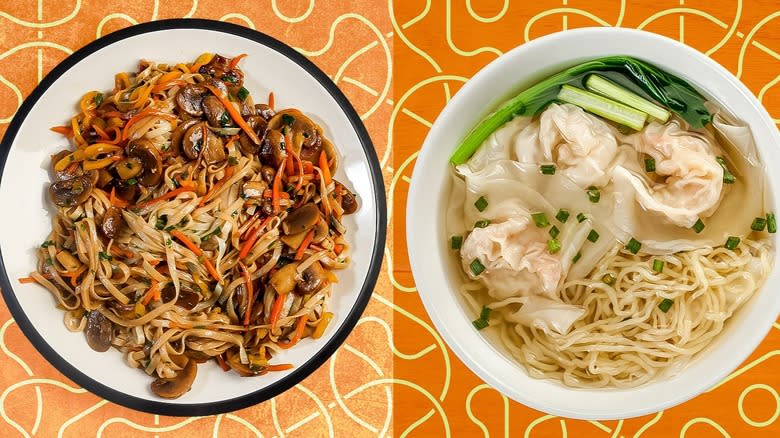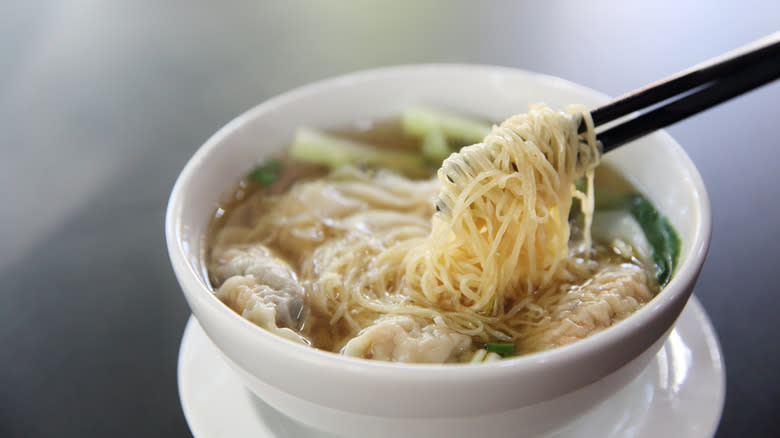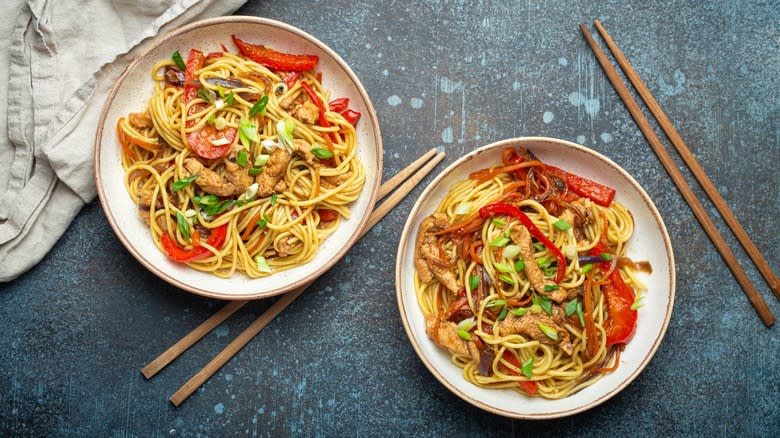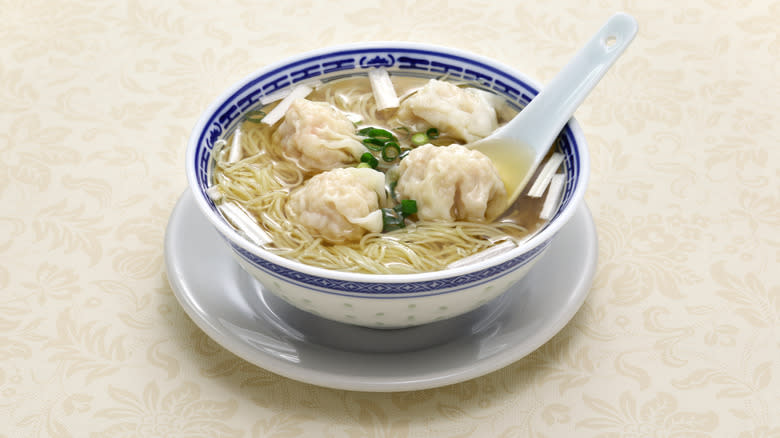Lo Mein Vs Huntun Mian: What's The Difference?

If you've ever patronized your local Chinese takeout restaurant (and, really, would you be reading an article on a cooking website if you hadn't already trod the gastronomic promised land?), then you already know about lo mein. It's a lighthouse to the self-professed "epicure" and the laid-back chower-downer alike. Those crave-able, slippery noodles are a staple comfort food for both college students cramming for finals and tenured professors chilling at home. Although, if you're less familiar with huntun mian, another noodle-based Cantonese dish, chances are you might know it by another name. And, if not, allow us the supreme (dare we say "delicious") pleasure of getting you two acquainted.
Both dishes share the same fundamental base: Mouth-watering, umami Chinese egg noodles made from wheat flour and eggs. Those comforting yellow-hued noodles tote a firm, springy bite and come in varying thicknesses -- which is the most obvious difference between lo mein and huntun mian. Lo mein is made from much thicker egg noodles and served on a plate, while huntun mian is made from ultra-thin egg noodles and served swimming in a bowl of broth.
Read more: Restaurant Foods That Always Taste Better Than What You Make At Home
What Is Lo Mein?

Lo mein (not to be confused with chow mein, which is fried) is made from the thickest type of Chinese egg noodles, the eponymous lo mein noodles. These are sturdy, linguine-esque jobbies about ¼-inch thick, typically used in stir-fry dishes and slathered in a rich, heavy sauce. In fact, lo mein (捞面) means "stirred," "mixed," "scooped," or "tossed" noodles in Cantonese. (Although, spaghetti noodles also work in a pinch, for the record.)
To make lo mein, the noodles are cooked in hot water, (parboiled for 2-3 minutes if fresh or 5-6 minutes if dried), drained, then transferred to a wok to stir-fry in sauce with veggies and protein. Common lo mein proteins include garlic chicken, roasted pork, shrimp, or it can be totally vegetarian. Classic lo mein sauce is typically some combination of light and dark soy sauce, oyster sauce, sesame oil, MSG, garlic, mirin, and sugar (we dig fermented honey garlic in our lo mein sauce, too). That signature rainbow myriad of lo mein veggies nearly always includes shredded napa or green cabbage and mung bean sprouts, but also often features matchstick carrots, bamboo shoots, mushrooms, snap peas, green onion, and water chestnuts.
What Is Huntun Mian?

Fans might know huntun mian by its other name: wonton noodles. Although, this name is somewhat redundant considering huntun mian is made with wonton noodles, the thinnest type of Chinese egg noodle. Delicate wonton noodles are typically used in broth-forward noodle soup dishes, and huntun mian is no exception.
Cantonese wonton noodle soup (港式云吞面) consists of thin wonton noodles and meat-filled wontons floating in a steaming bowl of broth. It's all about the interplay of taste and texture. The soup itself is often a chicken-based broth, in which bobs the filled wontons and the noodles, which are boiled just until al dente. Other versions make the broth from a flavorful combination of pork stock and dried shrimp rather than chicken. To serve, each bowl is garnished with diced scallions and baby bok choy. For more on nailing the perfect wonton noodle soup texture, we have some pro tips here.
Lo Mein Is A Noodle-Y Entree And Huntun Mian Is A Soup

Lo mein noodles are toothier than their light, springy wonton noodle counterparts, and they're served piled on a plate, not submerged in broth. These dense bad boys serve as an entree all on their own. In huntun mian, the noodles are only half of the picture.
Bobbing alongside those thin egg noodles are Hong Kong-style wontons, which are housed in square-shaped, yellow-hued egg-based wonton wrappers. Cantonese wonton wrappers often use the same dough as wonton noodles, and they're typically filled with a fragrant mixture of ground pork and shrimp. Fresh shrimp and pork with at least 20% fat content are the keys to nailing that trademark Cantonese flavor, richness, and binding the filling together structurally. But, you could also fill 'em with chicken or veggies to suit your taste preference.
If you're making huntun mian at home, store-bought frozen filled wontons (not to be confused with crab rangoons) also totally get the job done. Or, you could whip up a big batch of homemade wontons and freeze them for easy access in future recipes -- and you don't have to thaw them before cooking them!
Lo Mein Is A Takeout Superstar And Huntun Mian Is Better Enjoyed As A Sit-Down Dish

Huntun mian is a stripped-down delicacy, and subsequently dictates a stricter lineup of ingredients to achieve the right flavor. Conversely, lo mein can be a great dish for using up odds and ends in your fridge. A scrap of pork loin, a strip of firm tofu, one lonely bundle of asparagus, half a bell pepper -- throw it all in! Plus, dense lo mein holds up well for leftovers. Perhaps that's part of the reason why it's one of the most popular Chinese takeout dishes in the U.S.
Unlike those hearty noodles, huntun mian is warming yet light, not a belly bomb when it arrives in your tummy. It's simple to make at home, but also widely available in sit-down Cantonese restaurants or Chinatown enclaves of major U.S. cities -- not such a takeout-style dish. Per the lore, huntun mian might have started as a favorite snack of the wealthy foodies in Guangzhou, the capital and largest city of Guangdong province. Today, wonton noodle soup remains a popular traditional dish in the region and beyond. The dish is also colloquially called yong (蓉), and folks in China order the dish by asking for dai yong (大蓉), a "large" with 8 wontons, or sai yong (細蓉), a "small" with 4 wontons.
Read the original article on Tasting Table.

